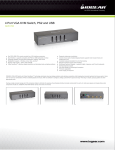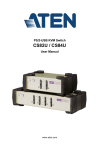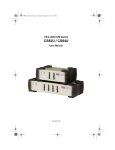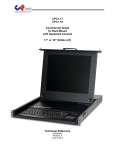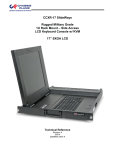Download iogear GCS1722 KVM switch
Transcript
User Manual VGA KVM Switch, PS2 and USB GCS1722/GCS1724 PART NO. M1258 / M1259 www.iogear.com -1- ©2013 IOGEAR. All Rights Reserved. PKG-M1258 / M1259 IOGEAR, the IOGEAR logo, are trademarks or registered trademarks of IOGEAR. Microsoft and Windows are registered trademarks of Microsoft Corporation. All other brand and product names are trademarks or registered trademarks of their respective holders. IOGEAR makes no warranty of any kind with regards to the information presented in this document. All information furnished here is for informational purposes only and is subject to change without notice. IOGEAR assumes no responsibility for any inaccuracies or errors that may appear in this document. Table of Contents Introduction4 Features5 Package Contents 6 System Requirements 6 Overview7 Hardware Installation 9 Operation11 Hotkey Operation 13 Port Switching 17 Hotkey Setting Mode (HSM) 21 Keyboard Emulation 22 Mac Keyboard Emulation 23 The Firmware Upgrade Utility 24 Factory Default Hotkeys Settings 25 Specifications 29 Troubleshooting30 Hotkey Default Settings 32 Federal Communication Commission Statement (FCC) Statement 33 CE Statement 33 Limited Warranty 34 Contact35 -3- Introduction IOGEAR’s VGA KVM Switch with Video DynaSync™ technology eliminates boot-up display problems and optimizes resolution while bringing dual console keyboard and mouse ports. Users can now use any combination of PS/2 or USB keyboard and mouse. With no software to configure, setting up GCS1722 / GCS1724 is quick and easy! The setup is simple; just plug cables into their appropriate ports. Having a single console manage all of the computers helps to eliminate the expense of purchasing individual console components for each unit, and saves space and energy those extra components would use. IOGEAR’s VGA KVM Switch saves users time and money! -4- Features • One PS/2-USB VGA console controls two (GCS1722) or four (GCS1724) VGA interface computers. • Dual Interface - supports computers with PS/2 or USB keyboards and mice • Computer selection via front panel pushbuttons, hotkeys, and mouse • Multiplatform support – Windows, Linux, Mac, and Sun* • Superior video quality – 2048 x 1536; DDC2B • Video DynaSync™ optimizes display resolution and eliminates boot-up display problems • Supports widescreen resolutions • Console mouse port emulation/bypass feature supports most mouse drivers and multifunction mice • Complete keyboard emulation for error-free booting • Mac/Sun keyboard support and emulation** • Multilingual keyboard mapping – supports English, Japanese, and French keyboards • Gaming keyboard support • Auto Scan Mode for monitoring all computers • Firmware upgradable • Power supply not required *See Hotkey Default Settings, page 32, for full details. **PC keyboard combinations emulate Mac/Sun keyboards; Mac/Sun keyboard work only with their own computers. -5- Package Contents –– –– –– –– 1 VGA KVM Switch, PS/2 and USB (GCS1722 or GCS1724) 2 or 4 Custom KVM Cable sets (2 for GCS1722, 4 for GCS1724) 1 User Manual 1 Warranty Card System Requirements Console –– A VGA compatible monitor capable of the highest possible resolution –– A USB or PS/2 mouse –– A USB or PS/2 keyboard Computer The following equipment must be available on each computer: –– A VGA port –– Type A USB ports or 6-pin Mini-DIN PS/2 ports -6- Overview Front View 1 1 2-Port VGA KVM Switch 4-Port VGA KVM Switch GCS1722 GCS1724 2 1. Port Selection Buttons • Press and release a switch to bring the KVM focus to the computer attached to its corresponding port. The Port LED lights bright orange. • Press and hold switches 1 & 2 for more than 2 seconds to start Auto Scan Mode, see page 14 for details. • Press and release either switch (1 or 2) to stop Auto Scan Mode. The KVM focus will go to the computer attached to the corresponding port. • Press switches 3 and 4 simultaneously for 2 seconds to perform a keyboard and mouse reset (GCS1724 only). AUTO SCAN K/M RESET 2 2. Port LEDs The Port LEDs are built into the Port Selection Switches. KVM Status LEDs: • Lights DIM ORANGE indicates the computer attached to the corresponding port is up and running (On Line). • Flashes indicates Firmware Upgrade mode is in effect. • Changes to BRIGHT ORANGE to indicate that the computer attached to its corresponding port is the one that has the KVM focus (Selected). • Flashes indicates that the computer attached to its corresponding port is being accessed under Auto Scan Mode. -7- Back View 1 2 3 1 4 1. Console Keyboard and Mouse Ports The cables from your USB or PS/2 console keyboard and USB or PS/2 console mouse plug in here. Each connector is marked with an appropriate icon to indicate itself. 2. Power Jack If you choose to use an external power, the power adapter cable plugs into this jack. (Power Adapter is optional and not included). 2 3 4 3. Console Monitor Port The cable from your VGA console monitor plugs into this port. 4. KVM Port Section The custom KVM cable sets that link the GCS1722 / GCS1724 to your computers plug in here. Each KVM port section is comprised of a single female SPHD18 port, which incorporates the USB, PS/2, and VGA connection. Note: 1. Use of a power adapter (DC5V) is optional, and requires a separate purchase. 2. The shape of the yellow KVM connectors has been specifically modified so that only custom KVM cables designed to work with this switch can plug in. Do NOT attempt to use ordinary 15-pin VGA connector cables to link these ports to the computer. -8- Hardware Installation Before you Begin Make sure that power to all the devices you will be connecting have been turned off. You must unplug the power cords of any computers that have the Keyboard Power On function. Otherwise, the switch will receive power from the computer. and / or To prevent damage to your installation, make sure that all devices on the installation are properly grounded. 1 STEP 1 Plug your keyboard and mouse into the USB or PS/2 console ports located on the unit’s rear panel. STEP 2 Plug your console monitor into the VGA console port located in the unit’s rear panel and power on the monitor. 2 -9- STEP 3 Using the custom KVM cable set (provided with this package), plug the custom SPHD connector into any available socket into the KVM port section of the switch. 4 STEP 4 At the other end of the cable, plug the USB or PS/2 and VGA connectors into their respective ports on the computer. Note: If you are using a combo console – for example, USB mouse and PS/2 keyboard – plug in both the USB and PS/2 connectors. 3 STEP 5 If you choose to use an external power, plug the power adapter into an AC power source, then plug power adapter cable into the switch’s Power Jack. STEP 6 Turn on the power to the computers. 5 - 10 - Operation There are three convenient methods to access the computers: Manual – which involves pressing the port selection switches located on the unit’s front panel; Mouse – which involves clicking the scroll wheel of the USB mouse; and Hotkey – which involves entering combinations from the keyboard. Hotkey port selection is discussed in the next chapter. Manual Switching For manual port selection: • Press and release a port selection switch to bring the KVM focus to the computer attached to its corresponding port. The Port LED lights BRIGHT ORANGE. • Press and hold port selection switch 1 and 2 for more than 2 seconds to start Auto Scan Mode, see page 14 for details. • Press and release either port selection switch (1 or 2) to stop Auto Scan Mode. The KVM focus goes to the computer attached to the corresponding port of the switch you pressed. • Press port selection switch 3 and 4 simultaneously for 2 seconds to perform a keyboard and mouse reset (GCS1724 only). Mouse Port-switching The GCS1722 / GCS1724 supports the very latest in mouse port-switching – simply double-click the scroll wheel of your USB mouse to cycle through the ports. 1. This feature is only supported by USB 3-key scroll wheel mice. 2. The default setting is disabled. 3. This feature is only supported when Mouse Emulation is enabled. See Mouse Port-switching, page 20, for details. - 11 - Powering off and Restarting If it becomes necessary to power off the GCS1722 / GCS1724 unit, must do the following: 1. Shut down all the computers that are attached to the switch. Note: You must unplug the power cords of any computers that have the Keyboard Power On function that are connected to the shutdown switches. Otherwise, the switches will still receive power from the computers. 2. Unplug the switch’s power adapter cable. 3. Wait 10 seconds, then plug the switch’s power adapter cable back in. 4. After the switch is up, power on the computers. Port ID Numbering Each KVM port section on the GCS1722 / GCS1724 switch is assigned a port number. (1 or 2 for GCS1722; 1 to 4 for GCS1724). The port numbers are marked on the rear panel of the switch (see page 8 for details). The Port ID of a computer is derived from the KVM port number it is connected to, for example, a computer connected to KVM port 2 has a Port ID of 2. The Port ID is used to specify which computer gets the KVM focus with the Hotkey port selection method (see page 13 for details). Alternative Manual Port Selection Settings When Hotkey Setting Mode has been activated, pressing [S] will invoke the alternative front panel pushbutton manual port selection functions as follows (also, see page 20): • Press a port selection switch once to bring the KVM focus to the computer attached to its corresponding port. • Press and hold port selection switches 1 and 2 for more than 2 seconds to start Auto Scan Mode, see page 14 for details. • Press port selection switches 3 & 4 simultaneously for 2 seconds to perform a keyboard and mouse reset (GCS1724 only). - 12 - Hotkey Operation The GCS1722 / GCS1724 provides an extensive, easy-to-use, hotkey function that makes it convenient to control and configure your KVM installation from the keyboard. Port Switching All port switches begin with tapping the Scroll Lock key twice. The tables below describe the actions that each combination performs. Note: If using the Scroll Lock key conflicts with other programs running on the computer, the Ctrl key can be used, instead. See Alternate Port Switching Keys, page 16 for details. Going Directly to a Port Cycling Through the Ports Hotkey [Scroll Lock] [Scroll Lock] [Enter] Hotkey Action [Scroll Lock] [Scroll Lock] [n] [Enter] Brings the KVM focus from the port that currently has the KVM focus to the next port on the installation (1 to 2; 2 to 1 for the GCS1722; 1 to 2; 2 to 3; 3 to 4; 4 to 1 for the GCS1724). Action Brings the KVM focus to the computer attached to the port corresponding to the specified Port ID Note: The n stands for the computer’s Port ID number (1, 2, 3, or 4). See “Port ID Numbering”on page 12. Replace the n with the appropriate Port ID when entering hotkey combinations. - 13 - Auto Scanning The GCS1722 / GCS1724’s Auto Scan feature automatically cycles the KVM focus through the computer ports at regular intervals. This allows you to monitor the computer activity without having to take the trouble of switching from port to port manually. See the table below for details. Hotkey Action [Scroll Lock] [Scroll Lock] [A] [Enter] Invokes Auto Scan. The KVM focus cycles from port to port at 5 second intervals. Five second intervals are the Default setting. [Scroll Lock] [Scroll Lock] [A] [Enter] [n] The KVM focus cycles from port to port at n second intervals. Replace the n with a number between 1 and 4 when entering this hotkey combination to set the number of seconds that the CS82U / CS84U should dwell on a port before moving on to the next, as follows: 1 = 3 seconds 2 = 5 seconds (default) 3 = 10 seconds 4 = 20 seconds Notes: 1. While Auto Scan Mode is in effect, ordinary keyboard and mouse functions are suspended – only Auto Scan Mode compliant keystrokes and mouse clicks can be inputted. You must exit Auto Scan Mode in order to regain normal control of the console. 2. Although the video focus switches from port to port, the keyboard and mouse do not switch. They stay at the port they were on when Auto Scanning started. 3. To exit Auto Scan Mode, press the Esc key or the Spacebar. - 14 - Hotkey Setting Mode (HSM) Hotkey Setting Mode is used to set up your GCS1722 / GCS1724 switch configuration. All operations begin with invoking Hotkey Setting Mode (HSM). Invoking HSM To invoke HSM do the following: 1. Press and hold down [Num Lock]. 2. Press and release [-]. 3. Release [Num Lock]. Note: 1. There is an alternate key combination to invoke HSM. See page 16 for details. 2. The minus key must be released within one half second, otherwise Hotkey invocation is canceled. When HSM is active, the Caps Lock and Scroll Lock LEDs flash in succession to indicate that HSM is in effect. They stop flashing and revert to normal status when you exit HSM. Ordinary keyboard and mouse functions are suspended – only Hotkey compliant keystrokes and mouse clicks (described in the sections that follow) can be inputted. At the conclusion of some hotkey operations, you automatically exit hotkey mode. With some operations, you must exit manually. To exit HSM manually, press the ESC key, or the SPACEBAR. - 15 - Alternate HSM Invocation Keys An alternate set of HSM invocation keys is provided in case the default set conflicts with programs running on the computers. To switch to the alternate HSM invocation set, do the following: 1. Invoke HSM (see page 15) 2. Press and release [H]. The HSM invocation keys become the Ctrl key (instead of Num Lock) and the F12 key (instead of minus). Note: This procedure is a toggle between the two methods. To revert back to the original HSM invocation keys, invoke HSM, then press and release the H key again. Alternate Port Switching Keys The port switching activation keys can be changed from tapping the Scroll Lock key twice ([Scroll Lock] [Scroll Lock]) to tapping the Ctrl key twice ([Ctrl] [Ctrl]). To change the port switching activation keys, do the following: 1. Invoke HSM (see page 15) 2. Press and release [T]. Note: This procedure is a toggle between the two methods. To revert back to the original [Scroll Lock] [Scroll Lock] method, invoke HSM, then press and release the T key again. - 16 - Port Switching Keyboard Language To change the keyboard language, do the following: 1. Invoke HSM (see page 15). 2. Press [F6] [nn] [Enter]. Note: nn is a two-digit number that represents the keyboard language code (US English: 33; French: 08; Japanese: 15). Keyboard Operating Platform The GCS1722 / GCS1724’s default port configuration is for a PC compatible keyboard operating platform. If your console uses a PC compatible keyboard and you have a Mac attached to a port, for example, you can change the port’s keyboard operating platform configuration so that the PC compatible keyboard emulates the Mac keyboard. The procedure is as follows: 1. Bring the KVM focus to the port you want to set. 2. Invoke HSM (see page 15) 3. Press and release the appropriate Function key (see table below). After completing this procedure, you automatically exit HSM. Hotkey Action [F2] Enables Mac keyboard emulation, see Mac Keyboard, page 23 for details. [F3] Enables Sun keyboard emulation, see Sun Keyboard, page 24 details. [F10] Automatically detects and sets the keyboard operating platform. - 17 - List Switch Settings To see a listing of the current switch settings, do the following: 1. Open a text editor or word processor and place the cursor in the page window. 2. Invoke HSM (see page 15). 3. Press and release [F4] to display the settings. USB Reset If the USB loses focus and needs to be reset, do the following: 1. Invoke HSM (see page 15). 2. Press and release [F5]. Hotkey Buzzer Control The Buzzer can be hotkey toggled on and off. To toggle the Buzzer, do the following: 1. Invoke HSM (see page 15). 2. Press and release [B]. The Buzzer toggles on or off. Disable Port Switching Keys To disable the Port Switching Keys ([Scroll Lock] [Scroll Lock] / [Ctrl] [Ctrl]), do the following: 1. Invoke HSM (see page 15). 2. Press [X] [Enter]. Note: This procedure is a toggle. To enable the Port Switching keys repeat steps 1 and 2. - 18 - Firmware Upgrade Mode To set the GCS1722 / GCS1724 to Firmware Upgrade Mode, do the following: 1. Invoke HSM (see page 15). 2. Key in: upgrade 3. Press [Enter]. All front panel LEDs (green and orange) flash to indicate Firmware Upgrade Mode is in effect. Note: To exit Firmware Upgrade Mode, you must power off the switch. Restore Default Settings To reset the GCS1722 / GCS1724 to its default hotkey settings, do the following: 1. Invoke HSM (see page 15). 2. Press [R][Enter]. See Hotkey Default Settings, page 32 Video DynaSync™ To invoke Video DynaSync™, ATEN’s exclusive technology that eliminates boot-up display problems and optimizes resolution when switching between ports, do the following: 1. Invoke HSM (see page 15). 2. Press [D]. - 19 - Mouse Port-switching To enable/disable the Mouse Port-switching function, do the following: 1. Invoke HSM (see page 15). 2. Press [W]. Note: 1. This procedure is a toggle. 2. The default setting is disabled. 3. The feature is only supported when mouse emulation is enabled. Mouse Emulation Control To toggle between mouse emulation enabled and disabled, do the following: 1. Invoke HSM (see page 15). 2. Press [M]. Keyboard Emulation Control To toggle between keyboard emulation enabled and disabled, do the following: 1. Invoke HSM (see page 15). 2. Press [N]. Note: When keyboard emulation is disabled, the [m], [w], [F2], [F3], [F10], [F4], [F5], and [F6] hotkeys are disabled. Other OS Mode To reset keyboards and mice for operating systems that do not support USB 2.0, do the following: 1. Invoke HSM (see page 15). 2. Press [F1]. - 20 - Hotkey Setting Mode (HSM) HSM Summary Table After invoking HSM (see page 15), key in one of the following keys to perform the corresponding function: Key [H] [T] Function Toggles between the default ([Num Lock] [-]) and alternate ([Ctrl] [F12]) HSM invocation keys. Toggles between the default ([Scroll Lock] [Scroll Lock]) and alternate ([Ctrl] [Ctrl]) Port Switching keys. [B] Key Function Note: nn is a two-digit number that represents one of the following keyboard language code: US English: 33; French: 08; Japanese: 15. [X] [Enter] Enables/Disables the buzzer. [R] [Enter] Enables/Disables the port switching keys. Resets the hotkey settings to their default status. [F2] Enables Mac keyboard emulation. [u] [p] [g] [r] [a] [d] [e] [Enter] [F3] Enables Sun keyboard emulation. [D] Invokes Firmware Upgrade Mode. [N] Invokes Video DynaSync™, ATEN’s exclusive technology that eliminates boot-up display problems and optimizes resolution when switching between ports. [F10] Automatically detects and sets the keyboard operating platform. [F4] Prints the switch’s current settings via a text editor or word processor. [M] Enables/Disables keyboard emulation. Performs a reset on all USB devices. [W] Enables/Disables mouse emulation. [F1] Enables/Disables mouse port-switching. [F5] [F6] [nn] [Enter] Sets the keyboard language. Resets keyboard and mouse under operating systems that do not support USB 2.0. - 21 - Keyboard Emulation Mac Keyboard The PC compatible (101/104 key) keyboard can emulate the functions of the Mac keyboard. The emulation mappings are listed in the table below. PC Keyboard [Shift] Mac Keyboard Shift PC Keyboard [Print Screen] Mac Keyboard F13 [Crtl] Ctrl [Scroll Lock] F14 = [Ctrl] [1] [Enter] Return [Ctrl] [2] [Backspace] Delete [Ctrl] [3] [Insert] Help [Ctrl] [4] [Ctrl] F15 [Alt] Alt *Note: When using key combinations, press and release the first key (Ctrl), then press and release the second key. - 22 - Mac Keyboard Emulation Sun Keyboard The PC compatible (101/104 key) keyboard can emulate the functions of the Sun keyboard. The emulation mappings are listed in the table below PC Keyboard Sun Keyboard [Crtl] [t] Stop [Crtl] [1] [Crtl] [F2] Again [Crtl] [2] [Crtl] [F3] Props [Crtl] [F4] Undo [Crtl] [F5] Front [Crtl] [F6] Copy [Crtl] [F7] Open [Crtl] [F8] Paste [Ctrl] [F9] Find [Crtl] [F10] Cut PC Keyboard Sun Keyboard [Crtl] [3] [Crtl] [4] [Crtl] [H] Help Compose Note: When using key combinations, press and release the first key (Ctrl), then press and release the activation key. - 23 - The Firmware Upgrade Utility The Windows-based Firmware Upgrade Utility (FWUpgrade.exe) provides a smooth, automated process for upgrading the KVM switch’s firmware. The Utility comes as part of a Firmware Upgrade Package that is specific for each device. New firmware upgrade packages are posted on our website as new firmware revisions become available. Check the website regularly to find the latest packages and information relating to them: http://www.iogear.com Before you Begin To prepare for the firmware upgrade, do the following: 1. From a computer that is not part of your KVM installation, go to our IOGEAR support site and select the product part number (GCS1722 or GCS1724) to get a list of available Firmware Upgrade Packages. 2. Choose the Firmware Upgrade Package you want to install (usually the most recent), and download it to your computer. 3. Disconnect the GCS1722 / GCS1724 from your KVM installation and power it off. Connect one of the custom KVM cable set’s Type A USB connectors to a USB hub port on your computer. 4. At the other end of the custom KVM cable set, connect the SPHD connector to the Port 1 KVM section. 5. Invoke Firmware Upgrade Mode (see Firmware Upgrade Mode, page 19). The front panel LEDs flash to indicate that Firmware Upgrade Mode is in effect. - 24 - Factory Default Hotkeys Settings 4-Port VGA KVM Switch GCS1724 AUTO SCAN K/M RESET 3 5 5 4 - 25 - Starting the Upgrade To upgrade your firmware: 1. Run the downloaded Firmware Upgrade Package file – either by double-clicking the file icon, or by opening a command line to enter the full path to it. The Firmware Upgrade Utility Welcome screen appears: 2. Read and Agree to the License Agreement (enable the I Agree radio button). 3. Click Next to continue. The Firmware Upgrade Utility main screen appears: The Utility inspects your installation. All the devices capable of being upgraded by the package are listed in the Device List panel. - 26 - 4. As you select a device in the list, its description appears in the Device Description panel. 5. After you have made your device selection(s), Click Next to perform the upgrade. If you enabled Check Firmware Version, the Utility compares the device’s firmware level with that of the upgrade files. If it finds that the device’s version is higher than the upgrade version, it brings up a dialog box informing you of the situation and gives you the option to continue or cancel. If you didn’t enable Check Firmware Version, the Utility installs the upgrade files without checking whether they are higher level, or not. - 27 - Upgrade Succeeded As the Upgrade proceeds status messages will appear in the Status Messages panel, and the progress toward completion is shown on the Progress bar. Upgrade Failed If the Upgrade Succeeded screen doesn’t appear, it means that the upgrade failed to complete successfully, in which case you should do the following: After the upgrade has completed, a screen appears to inform you that the procedure was successful: 1. Press and hold the Port 1 selection switch. While you are holding the switch, connect the GCS1722 / GCS1724 to the computer using the USB cable of the custom cable set (see diagram, page 25) to enter Firmware Upgrade Mode. The front panel LEDs flash to indicate that Firmware Upgrade Mode is in effect. 2. Run the upgrade again. See Starting the Upgrade, page 26. Click Finish to close the Firmware Upgrade Utility. After a successful completion, the GCS1722 / GCS1724 exits Firmware Upgrade Mode, and resets itself. - 28 - Specifications Function Computer Connections Port Selection Keyboard Console Ports Connectors Video Mouse KVM Ports LEDs Emulation Video 4 1 x DC Jack 1 x DC Jack Selected 2 x Pushbutton 4 x Pushbutton On Line 2 (Orange) 4 (Orange) Selected 2 (Green) 4 (Green) Keyboard / Mouse USB 2048 x 1536 @ 60Hz; DDC 2B Scan Interval Power Consumption 3, 5, 10, 20 secs. (5 secs. default) DC 5V, 1.1W DC 5V, 1.2W 0 ~ 50°C Operating Temp. Environment GCS1724 2 Front panel Pushbuttons; Hotkey, USB Mouse 1 x USB Type A Female (Black) 1 x 6-pin Mini-DIN Female (Purple) 1 x HDB-15 Female (Blue) 1 x USB Type A Female (Black) 1 x 6-pin Mini-DIN Female (Green) 2 x SPHD-18 Female (Yellow) 4 x SPHD-18 Female (Yellow) Power (Optional) Switches GCS1722 Storage Temp. -20 ~ 60°C Humidity 0 ~ 80% RH, Non-condensing Housing Physical Properties Metal Weight Dimensions (L x W x H) 0.54 kg 0.77 kg 14.00 x 8.70 x 5.50 cm 21.00 x 8.70 x 5.50 cm - 29 - Troubleshooting Operation problems can be due to a variety of causes. The first step in solving them is to make sure that all cables are securely attached and seated completely in their sockets. In addition, updating the product’s firmware may solve problems that have been discovered and resolved since the prior version was released. If your product is not running the latest firmware version, we strongly recommend that you upgrade. See The Firmware upgrade Utility for details. Symptom Erratic behavior. Possible Cause Unit not receiving enough power. Action Use a DC 5 V power adapter if you are not already using one. If you are already using a power adapter, check that it matches the system specifications, and that it is plugged in and functioning properly. Keyboard and/or mouse need to be reset. Unplug the cable(s) from the console port(s), then plug it/them back in. USB devices not responding. No connection to the computer. Check the cable from the switch to the computer to make sure it is properly connected. KVM switch needs to be reset. Power off all devices on the installation; power off the KVM switch; wait five seconds; then power up. USB ports need to be reset. Unplug the device’s USB cable from the USB port on the switch’s rear panel, then plug it back in. Use the USB Reset hotkey combination (see page 18), to reset the USB ports. - 30 - Symptom Possible Cause Action Cannot switch ports by pressing [Scroll Lock] twice Keyboard is incompatible with Scroll Lock invocation. Power off all devices on the installation; power off the switch; confirm all KVM cables are properly connected; power on the switch; power on the computers Monitor does not display after KVM cable set is hot plugged. Some graphics cards are incompatible with cable set hot plugging. Power off all devices on the installation; power off the switch; confirm all KVM cables are properly connected; power on the switch; power on the computers When switching ports, the monitor does not display. Monitor is new or this is the first time installation. Switch ports again and wait two or more seconds for the PC’s EDID to pass to the monitor. The PC’s EDID has not passed through to the monitor when switching ports. Use the [d] hotkey to invoke Video DynaSync one more time or switch to another PC to reconnect the switch. See HSM Summary Table, page 21. - 31 - Hotkey Default Settings The hotkey factory default settings are as follows: Setting Hotkey Default Port switching [T] [Scroll Lock] [Scroll Lock] Invoking HSM [H] [Number Lock] [-] Auto Scan Interval [Scroll Lock] [Scroll Lock] [A] [Enter] 5 seconds Keyboard Operating Platform [F10] PC Compatible Mouse Emulation [M] Enabled Keyboard Emulation [N] Enabled Mouse Port-switching [W] Disabled Video DynaSync™ [D] Enabled Port Switching Keys (On/Off) [X] [Enter] Enabled Buzzer [B] Enabled Keyboard Language [F6] [nn] [Enter] Note: nn is the language number English About SPHD Connectors This product uses SPHD connectors for its KVM and/or Console ports. We have specifically modified the shape of these connectors so that only KVM cables that we have designed to work with this product can be connected. - 32 - Federal Communication Commission Statement (FCC) Statement This equipment has been tested and found to comply with the limits for a Class B digital device, pursuant to Part 15 of the FCC Rules. These limits are designed to provide reasonable protection against harmful interference in a residential setting. This product generates, uses, and can radiate radio frequency energy and, if not installed and used as directed, it may cause harmful interference to radio communications. Although this product complies with the limits for a Class B digital device, there is no guarantee that interference will not occur in a particular installation. CE Statement This device has been tested and found to comply with the following European Union directives: Electromagnetic Capability (2004/108/EC), Low Voltage (2006/95/EC) and R&TTED (1999/5/EC). - 33 - Limited Warranty WE’RE HERE TO HELP YOU! NEED ASSISTANCE SETTING UP THIS PRODUCT? Make sure you: 1. Visit www.iogear.com for more product information 2. Visit www.iogear.com/support for live help and product support Warranty Information This product carries a 3 Year Limited Warranty. For the terms and conditions of this warranty, please go to http://www.iogear.com/support/warranty Register online at http://www.iogear.com/register Important Product Information Product Model Serial Number - 34 - Contact IOGEAR Toll Free 866-9-IOGEAR (USA) Phone: 949-453-8782 19641 Da Vinci, Foothill Ranch, CA92610 www.iogear.com [email protected] - 35 - © 2013 IOGEAR®





































